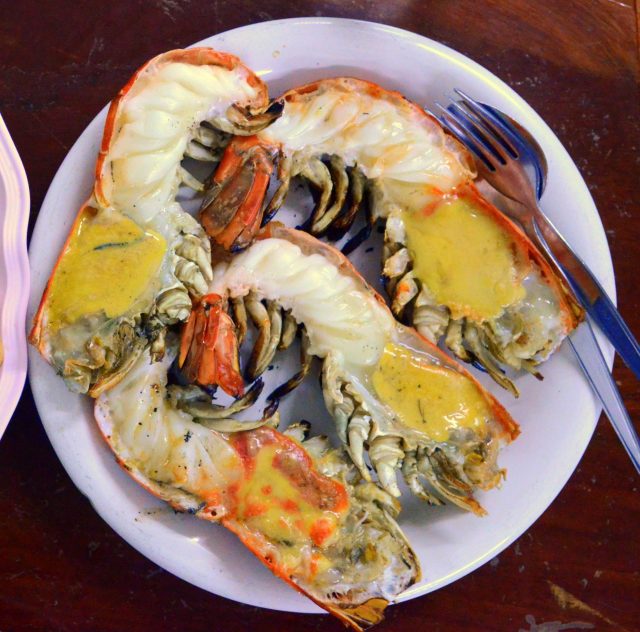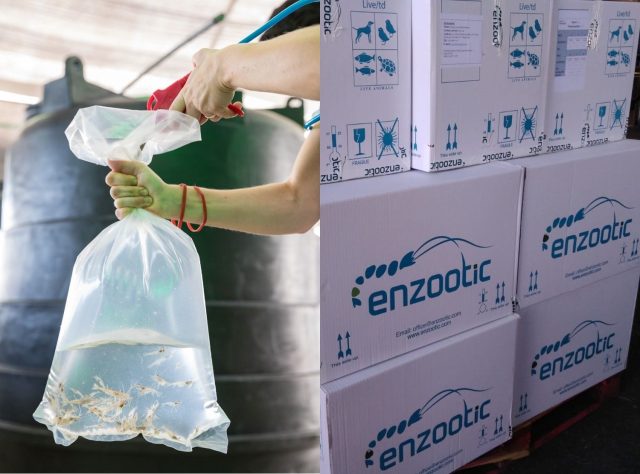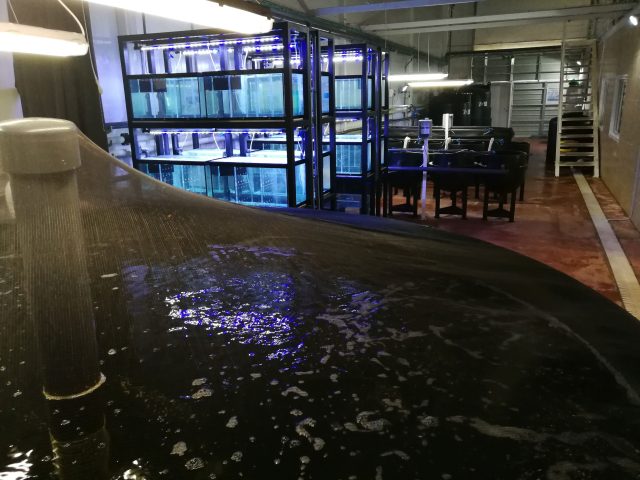Can a shrimp smile? It's tough to say whether the gangly, blue-legged crustaceans lurking within the massive aquaculture tanks are actually happy, but they certainly appear to be content. Perhaps it's because they are well-fed and blissfully unaware of what lies just outside the laboratory: the harsh, dry environment of Israel's Negev Desert, which is not a natural habitat for any form of aquatic life. It may also be because the tank contains an all-female population, devoid of males, which tend to be territorial, aggressive, and create stressful conditions that don't promote optimal growth.
Regardless of their state of mind, these placid crustaceans are the products of a unique gender-bending technique that promises to make them a delicious link toward a sustainable global food chain. Or, the technique could be the latest in a long line of developments that force us to take a careful look at the benefits and costs of achieving sustainability by intruding into the basic biology of the food we end up eating.
Gender-bending giants
In truth, the creatures in question are not shrimp; rather, they're a species of freshwater prawns, known to biologists as Macrobrachium rosenbergii. Commonly known as giant river prawns, they are a beloved staple of traditional Southeast Asian cuisine. Their flavor and amenability to simple aquaculture techniques made them a traditional cash crop for Thai, Malaysian, and Vietnamese farmers, who raise them in large outdoor ponds.
Despite their ability to quickly and efficiently convert feedstock into body mass, their adoption in other regions has been hampered by the jungle-bred prawns' narrow comfort zone. Because they don't do well in waters cooler than 26ºC (79ºF) or warmer than 30ºC (86ºF), attempts to cultivate them in most other regions have not gone well. The critters also need relatively spacious quarters to reduce growth-inhibiting interactions with aggressive territorial males, a requirement that makes raising them in the warm but more restricted confines of high-tech aquaculture systems less cost-effective.

Now, however, freshwater prawns may be able to enjoy wider commercial success, thanks to a new breeding technique developed by Enzootic, an Israeli agro-biotech venture founded in 2012 by Dr. Assaf Shechter and Professor Amir Sagi. One of the company's first initiatives was to develop and commercialize a technology for manipulating the gender of freshwater prawns in collaboration with Israels Ben-Gurion University of the Negev. This collaboration led to the creation of a one-time, non-chemical, non-genetic gender-bending treatment that allows freshwater hatcheries to produce crops of all-female prawns.
Breaking a different gender barrier
Single-sex populations may seem boring to us, but for the aquaculturist, they offer several advantages. For example, all-female freshwater prawn populations are very uniform in size and less aggressive, making it feasible to raise them in the more densely packed environments needed to make indoor aquaculture profitable. Shechter says that this and several other developments make it possible to raise freshwater prawns in highly productive commercial aquaculture systems that are far less polluting and require less space, energy, and water than today's operations. (All-male populations offer other advantages that improve productivity and profits in other types of production systems.)
While it is possible to hand-sort prawns for gender, the process is time-consuming and can only be done so far down the production cycle that it's not really practical. Enzootic's gender-bending process solves that problem by going upstream to the breeding process and making alterations in breeding females that cause them to produce broods of single-sex all-female offspring.
The prawns used in this process determine their sex in a manner somewhat analogous to how it works in humans: theres a chromosomal signal (think X/Y chromosomes) that is interpreted by an organ that makes hormones that control male and female development. But, unlike in humans, the mother can also influence the sexual development of the next generation.
Enzootics' process takes advantage of these features. It starts by surgically extracting the hormone-producing organ from "donor" males, which are then broken down into individual cells. When the cells are injected into young females, the hormones they produce cause the females to develop as males, despite their chromosomes. Just like natural male prawns, they can mate normally with other females, but some of their offspring possess a unique trait. Known as “super females,” they produce offspring that will develop as females regardless of the chromosomes they carry.
Enzootic has set up the genetics of its shrimp so that these super females are relatively easy to identify, and they can be used to quickly produce large populations of nothing but females. "Our goal was to take advantage of this natural and remarkable sexual plasticity to accomplish production of all-female populations without any kind of genetic modifications," says Shechter, Enzootic's co-founder.

Amir Sagi at Ben Gurion University of the Negev used many of the same insights on the factors that control sex differentiation of prawns enabled to develop a parallel technology for creating breeder prawns capable of producing only male offspring, a process that dramatically boosts the productivity of outdoor aquaculture operations. While all-female prawn populations are less aggressive and do better in the cramped confines of indoor tanks, males offer big advantages for operators using more spacious outdoor ponds.
The absence of females in outdoor ponds eliminates competition between males for mates that would normally result in injuries, deaths, and slower growth rates. Taking away the stimulus for aggressive behavior also reduces stress, allowing the prawns to direct even more of the calories they receive into growth. This can improve production by as much as 45 percent which, when combined with the Asian market's strong preference for the large prawns, could mean a 50- to 60-percent bump in a prawn farmer's income.
Both processes leave the prawns' natural genetic material untouched. In principle, this could avoid any potential real or imagined concerns about introducing "franken-prawns" into the food chain. The process, however, does involve some significant manipulation of the prawns biology, so the product might not be viewed as “natural” by people concerned about how their food is produced.
Beyond the consumer applications, Professor Sagi has also been involved in research on using the prawns to combat schistosomiasis, a debilitating waterborne disease that affects around 200 million people worldwide, primarily in impoverished areas. Also known as Snail Fever, the disease is caused by parasitic flatworms called schistosomes, which use aquatic snails as an intermediate host. Anyone swimming in, or drinking water inhabited by, these snails is likely to contract the disease, which can eventually lead to liver damage, kidney failure, infertility, or bladder cancer. In children, it may also inhibit growth and mental development.
Since the prawns are voracious predators of water snails, trials are underway to determine how commercial aquaculture operations can be most effectively configured for a parallel role as snail control centers. In a recent paper, Sagi and other proponents argue that the prawns could significantly reduce the number of infected people and the cost of the drugs required to treat them, plus the prawn ponds would provide permanent sources of food and income.

Making aquaculture sustainable
Sagi and Shechter say that giving aquaculturists a reliable way to produce crops of single-sex prawns will improve the efficiency and profitability for both traditional (extensive) and high-tech (intensive) operations. For example, Shechter cites several large-scale field studies that provide objective data that documents that all-female freshwater prawns thrive in higher stocking densities while demonstrating up to a 20-percent improvement in their Feed Conversion Ratios (FCR) when compared to a mixed-sex population. Since an all-female population can thrive in much higher population densities, operators are able to achieve far more production when limited space is available, as is the case for indoor intensive aquaculture settings.
They are also hopeful that their freshwater cultivation techniques will provide an alternative for prawn and shrimp farmers seeking to reduce the environmental impact of pond- and ocean-based crustacean aquaculture operations. For example, the cultivation of saltwater shrimp has drawn strong criticism because many production facilities in Asia and Southeast Asia are created by destroying vast stands of mangrove swamps, which are vital parts of the marine ecosystem.
Until recently, a combination of environmental, technical, and economic issues—along with the huge amounts of water required for a conventional outdoor freshwater farming operation—made North America a challenging place for aquaculturists to do business. This is changing, as the industry has begun to move away from open ponds farming and toward indoor operations based on recirculated aquaculture systems (RAS) that reuse most of their water.
Any aquaculture operation requires some amount of water exchange to keep the system healthy, but the small amount of the freshwater discharged from a prawn farm each day can be used to irrigate crops. Thats a serious bonus in sun-rich but water-starved areas such as Israel's Negev, as well as many parts of Africa and America's Southwest. Enzootic is wagering that these types of intensive indoor systems are the future of fish, shrimp, and prawn production and that the higher stocking densities made possible by their all-female breeding technology will help accelerate their adoption. In addition to their superprawns, they have developed their own indoor freshwater RAS breeding technology specifically optimized around M. rosenbergii's biological needs as a river organism.
To prove their point, Enzootic is building an indoor aquaculture facility located near Beersheba, the Negev's largest city. The demonstration farm's recirculating system only needs to exchange one percent of its tanks' capacity to keep the water and micro-ecosystem clean, balanced, and free of toxins. What's more, the exchange water, pulled from the tanks and bio-filtration system, is rich in natural fertilizers that can be used to irrigate and feed conventional or hydroponic food crops. "Since these are indoor farms, we have much better control over the water quality, and we have no need to use antibiotics, chemicals, or fertilizers" says Shechter.

Shechter claims that the advantages of indoor farming are already changing the global aquaculture industry and creating new opportunities in developed economies, such as North America. While he declined to discuss any American-based river prawn farming operations that Enzootics may have in the works, he said that the successful economics of using RAS-based indoor saltwater aquaculture systems for shrimp production are equally applicable to freshwater prawn farming.
One of the first commercially viable "farm to fork" indoor saltwater aquaculture operations in North America was Canadian Shrimp, run by Paul Cocchio and his son Brad. Read More – Source
[contf] [contfnew] 
arstechnica
[contfnewc] [contfnewc]







